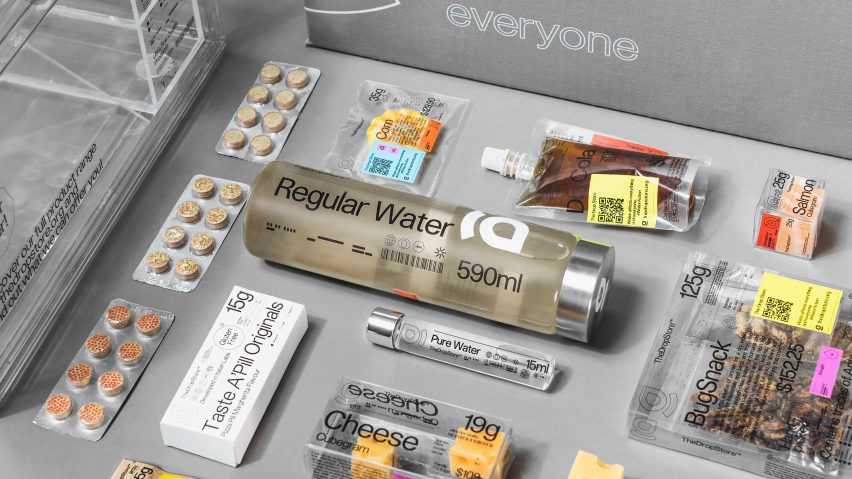To mark the UN Water Conference 2023, design agency Publicis Groupe Benelux has created a range of conceptual "supermarket" products that show what consumption could look like in a world with less water.
Commissioned through an initiative by the Netherlands' Department Ministry of Foreign Affairs, the Drop Store initiative was carried out by Publicis Groupe to show consumers what life might look like in a water-scarce future.
The design features packaging with small amounts of food and discoloured water that reflect the portions and prices that may become a reality if the water crisis – which currently sees two billion people living without safe drinking water – continues.
"[The United Nations] wanted us to spread this message globally for people to understand the value of the water," said Publicis COO Eduardo Marques, who was charged with developing a campaign to raise awareness of the ongoing issue.
Marques and his team chose a product-oriented approach because seeing items in this context would make the realities of water scarcity more "relatable" for people, the agency said.
This approach also led the team to create graphics and branding more familiar to the younger generations, as Marques believes they are more likely to be messengers for the initiative.
All of the items designed for the "supermarket" feature fictitious prices and realistic branding, such as a package with 35 grams of corn for $129 USD labelled as a "super offer!"
Various labels show the types of water events that would lead to the need for each product. These include "drought" for the production of bug protein when there is not enough water for livestock.
Through this visualisation, Marques said, the wide-reaching effects of water inaccessibility and pollution can be seen to affect wider aspects of the supply chain beyond just water itself.
"There is water in everything we eat and consume in our lives," Marques told Dezeen.
"So instead of having nutrition facts on the labels of the product, we actually have how many litres of water you need to produce that type of product."
The actual water included as part of the project is present in small vials labelled "regular" and "pure" – with the regular vials having a murky and brown shade. The pure vials have clear water but are very small, containing only 15 millilitres.
This presentation was implemented to demonstrate the growing scarcity of pure water.
"I think that will be the face of regular water in the future if we don't take action," Marques said.
"Drinkable water and pure clean water will be very, very scarce. That's the message. We want people to understand that this is going to be a luxury in the future."
Mitigating these problems will require better conservation of wastewater and management of water resources, diet and prevention of pollution in shared water sources.
While dietary habits like veganism have effects, Marques said that he also hopes corporations will see the message.
The team reached out to brands such as Domino's Pizza and Burger King, under the assumption that with scarcity there won't be enough water to "make [their] burger or [their] pizza", Marques said.
The UN Water Conference took place from 22 to 24 March in New York City, with Tajikistan and the Netherlands as host countries.
The conference resulted in the adoption of the Water Action Agenda, an agreement that included a number of "non-binding" recommendations for buoying water security worldwide.
Already, the effects of lessening water resources have been felt in developed nations, which have previously been insulated from some of the worst effects of droughts felt in places like the Horn of Africa.
In January, six states in the western United States agreed to cut water usage from the shared Colorado River Water Basin as the water levels in the dams along that river reach record lows, which has had negative effects on agriculture and husbandry in the region.
Other speculative projects that highlight the problems of water scarcity include plans for water-harvesting skyscrapers by BPAS Architects.
A number of designers have conceived of designs that harvest water from the air, including Hong Kong studio Orient Occident Atelier's community centre in Cambodia with a built-in roof that funnels rainwater.
Project credits:
Agency: Publicis Groupe Benelux
Client: Department Ministry of Foreign Affairs of the Kingdom of the Netherlands
Digital agency: Neverland
Consultancy: HUMИN
Design company: PLANT
Audio: Massive Music
Product design: Street Media Factory
Web development: Owow

